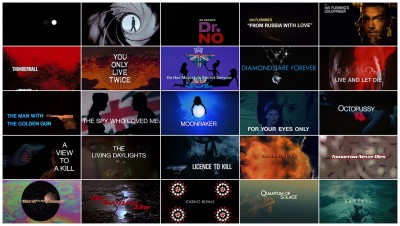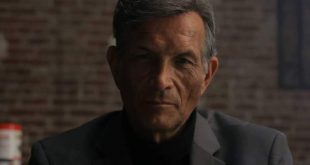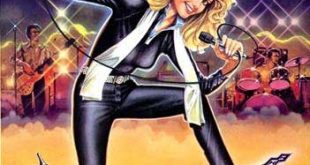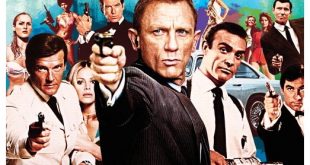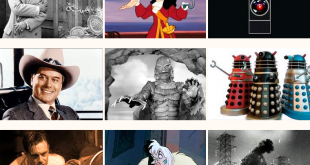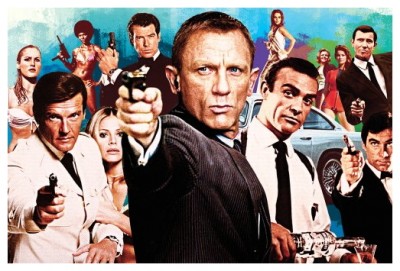 He may not have been a great producer – the case is arguable – but he certainly was a smart operator. In partnership with Harry Saltzman for fifteen years, Albert R. ‘Cubby’ Broccoli (1909-1996) revolutionised genre cinema by showing the major studios that it could actually be profitable. He thus opened the door to the multi-million-dollar financing of fantastic films, without which the genre could not have reached the dizzying heights (and abysmal depths) of today. Broccoli did this by producing a series of super-spy adventure movies featuring James Bond, a modern-day swashbuckling killer and lover, originally the creation of bestselling author Ian Fleming.
He may not have been a great producer – the case is arguable – but he certainly was a smart operator. In partnership with Harry Saltzman for fifteen years, Albert R. ‘Cubby’ Broccoli (1909-1996) revolutionised genre cinema by showing the major studios that it could actually be profitable. He thus opened the door to the multi-million-dollar financing of fantastic films, without which the genre could not have reached the dizzying heights (and abysmal depths) of today. Broccoli did this by producing a series of super-spy adventure movies featuring James Bond, a modern-day swashbuckling killer and lover, originally the creation of bestselling author Ian Fleming.
From the beginning, the Bond movies have never been hardcore fantasy, but they are the kind of fringe fantasy that was first popularised by the Doctor Mabuse films of the twenties and the Fu Manchu films of the thirties, adventures featuring super-villians and mad scientists out to control the world and an assortment of implausible scientific gadgetry. While purporting to take place in the real world, most of the Bond films are, to varying degrees, science fiction. They are also fantastic in the psychological sense, by which I mean they create fantasies of potency, of urbanity, of guilt-free mayhem – impossible in the real lives of ordinary people.
Also read: A Brief History Of Bond, James Bond (1987-2013)
 It’s interesting today to see how much the series has changed over the years – bigger is not necessarily better. Little-known actor Sean Connery became a superstar overnight as the dashing, debonair British agent 007, a new type of hero: He had a license to kill; practiced judo; was a well-educated gentleman; dressed well; had great taste in food, met only beautiful women, could take on villains, traveled to exotic locations; refused to panic when the fate of the world rested on his shoulders; had charm and a subtle sense of humour; and had his own theme music that would play just by saying his name.
It’s interesting today to see how much the series has changed over the years – bigger is not necessarily better. Little-known actor Sean Connery became a superstar overnight as the dashing, debonair British agent 007, a new type of hero: He had a license to kill; practiced judo; was a well-educated gentleman; dressed well; had great taste in food, met only beautiful women, could take on villains, traveled to exotic locations; refused to panic when the fate of the world rested on his shoulders; had charm and a subtle sense of humour; and had his own theme music that would play just by saying his name.
The story of Doctor No (1962), concerning Bond and beautiful Honeychile Ryder (Ursula Andress) tracking down master villain Doctor No (Joseph Wiseman) on Crab Key Island near Jamaica, may sound like an old movie serial but producers Broccoli and Saltzman kept the film from deteriorating to a juvenile level. The movie has sex, violence, wit, fantastic action and colourful atmosphere. Connery, Wiseman and Andress all give memorable performances. Admittedly, there’s a bit of a slow patch in the middle and Doctor No could use a decent henchman, but otherwise the movie works marvelously, definitely different for its era. Looking back, one can understand why it caused so much excitement.
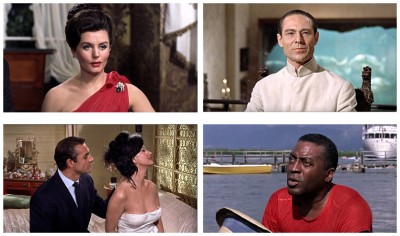 The plots of the Bond movies are repetitive to say the least. Almost invariably they feature an evil genius holding the world to ransom. In Doctor No (1962) and You Only Live Twice (1967), it’s spacecraft belonging to great powers that are interfered with and kidnapped. The same applies to The Spy Who Loved Me (1977), only this time it’s with submarines. On Her Majesty’s Secret Service (1969) threatens the world with a virus that kills plants and animals, and Moonraker (1979) with a virus that kills people.
The plots of the Bond movies are repetitive to say the least. Almost invariably they feature an evil genius holding the world to ransom. In Doctor No (1962) and You Only Live Twice (1967), it’s spacecraft belonging to great powers that are interfered with and kidnapped. The same applies to The Spy Who Loved Me (1977), only this time it’s with submarines. On Her Majesty’s Secret Service (1969) threatens the world with a virus that kills plants and animals, and Moonraker (1979) with a virus that kills people.
All these plot devices are patently science fiction. On the other hand, Live And Let Die (1973) is the only one in the franchise to touch upon supernatural fantasy. The rights to Fleming’s first Bond novel, Casino Royale, were first purchased to produce a live television play in 1954 starring Barry Nelson as CIA agent Jimmy Bond, Michael Pate as British MI6 agent Felix Leiter, and Peter Lorre as the villainous Le Chiffre. Although a great deal of fun to watch today, it was always considered below-average, both as a James Bond adventure and as a live television play. Lines are flubbed, and both the sound and staged effects are poor at the best of times (in the opening scene for instance, gunshots and their squibs are way out of sync).
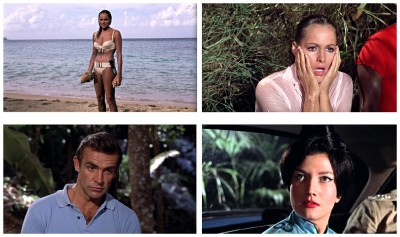 Doctor No (1962) was the first Bond film to be produced by Broccoli and it set the pattern: a guest star to play the sinister super-villain; Bond himself (handsome, sardonic, wisecracking, efficient, amoral); several beautiful girls for him to have sex with; one of whom is almost always killed. Joseph Wiseman, who plays Doctor No, remains one of the best villains in a Bond movie, ruthlessly polite and both metaphorically and literally metallic – he has prosthetic hands made of steel. None of the movies are artistically great though all, to a degree, are entertaining. They are not really films with a narrative structure, they are fantastic episodes of violence strung loosely together, thus there is seldom a sense of a Bond film growing and intensifying towards a genuine climax. They are, in fact, nothing but a series of climaxes, each set-piece exciting but none wholly satisfying, because none of them have a sense of completeness or inevitability. This became much more obvious in the late seventies, in fact The Spy Who Loved Me (1977) and Moonraker (1979) are prime examples of narrative structure so arbitrary as to appear entirely random.
Doctor No (1962) was the first Bond film to be produced by Broccoli and it set the pattern: a guest star to play the sinister super-villain; Bond himself (handsome, sardonic, wisecracking, efficient, amoral); several beautiful girls for him to have sex with; one of whom is almost always killed. Joseph Wiseman, who plays Doctor No, remains one of the best villains in a Bond movie, ruthlessly polite and both metaphorically and literally metallic – he has prosthetic hands made of steel. None of the movies are artistically great though all, to a degree, are entertaining. They are not really films with a narrative structure, they are fantastic episodes of violence strung loosely together, thus there is seldom a sense of a Bond film growing and intensifying towards a genuine climax. They are, in fact, nothing but a series of climaxes, each set-piece exciting but none wholly satisfying, because none of them have a sense of completeness or inevitability. This became much more obvious in the late seventies, in fact The Spy Who Loved Me (1977) and Moonraker (1979) are prime examples of narrative structure so arbitrary as to appear entirely random.
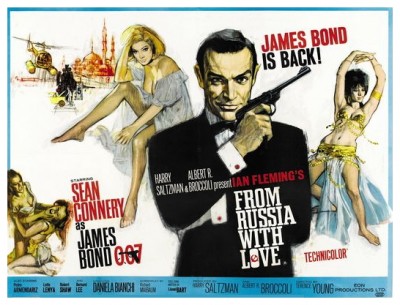 Doctor No (1962) lacks some of the external gloss of the subsequent films but, on the other hand, it has the strongest narrative thrust and also benefits from having its humour moderately restrained. At the outset, Bond was more of a real character, less a bundle of affectations. He was, incidentally, more cruel as well. From Russia With Love (1963) is an excellent, surprisingly tough and gritty Bond film, the second in the series. SPECTRE devises a plan that will result in warfare between the Soviets and the free world.
Doctor No (1962) lacks some of the external gloss of the subsequent films but, on the other hand, it has the strongest narrative thrust and also benefits from having its humour moderately restrained. At the outset, Bond was more of a real character, less a bundle of affectations. He was, incidentally, more cruel as well. From Russia With Love (1963) is an excellent, surprisingly tough and gritty Bond film, the second in the series. SPECTRE devises a plan that will result in warfare between the Soviets and the free world.
They want to frame 007 for the murder of a Soviet agent (Daniela Bianchi) who has become his lover. Actually, deadly assassins (Robert Shaw and Lotte Lenya) intends to kill them both. The film is refreshingly free of the gimmickry that would characterise the later films, and Connery and Bianchi play real people. They play it straight with excellent results: we worry about them and hope their relationship will work out. Shaw and Lenya are splendid villains, and both have excitingly-choreographed fights with Bond, powerfully directed by Terence Young. The lovely Bianchi should have been a bigger star – she is one of the most appealing of the Bond heroines.
 If the first two films set up the character of James Bond, the third film – Goldfinger (1964) – established the ingredients for Bond films to come. It has two diabolical villains: gold-mad Auric Goldfinger (Gert Frobe) and his seemingly invincible henchman Oddjob (Harold Sakata) with a blade-rimmed bowler hat. Two sexy women for Bond to seduce: blonde Jill Masterson (Shirley Eaton) who dies covered in gold paint and brunette ‘Pussy’ Galore (Honor Blackman), a pilot with bisexual tendencies who falls for Bond’s charms. There’s lots of humour, action, gimmicks (introducing the famous Aston Martin with its passenger ejection seat), an amusing yet tense golf game between Bond and Goldfinger, thrilling fights to the death, and a fascinating central crime: Goldfinger wants to destroy the gold in Fort Knox to both ruin America’s economy and greatly increase the value of his own gold.
If the first two films set up the character of James Bond, the third film – Goldfinger (1964) – established the ingredients for Bond films to come. It has two diabolical villains: gold-mad Auric Goldfinger (Gert Frobe) and his seemingly invincible henchman Oddjob (Harold Sakata) with a blade-rimmed bowler hat. Two sexy women for Bond to seduce: blonde Jill Masterson (Shirley Eaton) who dies covered in gold paint and brunette ‘Pussy’ Galore (Honor Blackman), a pilot with bisexual tendencies who falls for Bond’s charms. There’s lots of humour, action, gimmicks (introducing the famous Aston Martin with its passenger ejection seat), an amusing yet tense golf game between Bond and Goldfinger, thrilling fights to the death, and a fascinating central crime: Goldfinger wants to destroy the gold in Fort Knox to both ruin America’s economy and greatly increase the value of his own gold.
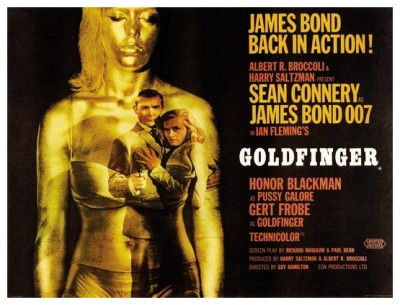 In the minds of many, James Bond is still Sean Connery, an intelligent macho actor who made the part very much his own. He played the role in the first five films, dropped out for On Her Majesty’s Secret Service (1969) – replaced with bare competence by Australian George Lazenby – to return for the seventh, Diamonds Are Forever (1971). The fifth of these, You Only Live Twice (1967), was notable for its elaborate sets, designed in a spacial, clinical, rather expressionist style by Ken Adam, one of them (a rocket launch pad inside a volcano) at the then-extraordinary cost of…one million dollars! Mwah-ha-ha!
In the minds of many, James Bond is still Sean Connery, an intelligent macho actor who made the part very much his own. He played the role in the first five films, dropped out for On Her Majesty’s Secret Service (1969) – replaced with bare competence by Australian George Lazenby – to return for the seventh, Diamonds Are Forever (1971). The fifth of these, You Only Live Twice (1967), was notable for its elaborate sets, designed in a spacial, clinical, rather expressionist style by Ken Adam, one of them (a rocket launch pad inside a volcano) at the then-extraordinary cost of…one million dollars! Mwah-ha-ha!
Adam worked on seven of the Bond films, from Doctor No (1962) to Moonraker (1979), after which set decorator Peter Lamont took over as production designer. In You Only Live Twice, Bond is again trying to prevent a nuclear war: Someone’s snatched an American rocket, and the chief suspect is Russia. Bond pretends to be killed so he can do his snooping without anyone looking for him. He discovers that the culprit is SPECTRE’s Ernst Blofeld (Donald Pleasence) whose headquarters are located beneath the aforementioned volcano. Not quite as good as previous Bonds, it’s still a very entertaining effort, but the formula was becoming a little stale – screenwriter Roald Dahl took great liberties with Fleming’s original novel, and the whole affair could have been trimmed maybe twenty minutes.
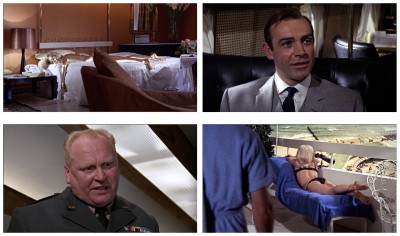 Much of Bond’s audience consists of teenagers and children, and part of Broccoli’s achievement was in taking genre cinema back to the era of family-friendly movies and away from adults-only horrors. In fact, he once made a film specifically for children. Based on a picture book written by the author of the Bond books, it was Chitty Chitty Bang Bang (1968), made by the team who made the Bond films, adapted for the screen by Roald Dahl. Dick Van Dyke stars as an eccentric inventor who creates a flying car and Gert Frobe, who was much better as Goldfinger (1964), plays the evil Baron Bombast who steals it. In fact the entire film plays out like a steam-punk musical parody of James Bond. The flying car effects are jolly enough but rather fake-looking, the songs are forgettable and the entire two-and-a-half hours finally collapses under its own weight. It flopped, and it was back to the Bond drawing board for Broccoli.
Much of Bond’s audience consists of teenagers and children, and part of Broccoli’s achievement was in taking genre cinema back to the era of family-friendly movies and away from adults-only horrors. In fact, he once made a film specifically for children. Based on a picture book written by the author of the Bond books, it was Chitty Chitty Bang Bang (1968), made by the team who made the Bond films, adapted for the screen by Roald Dahl. Dick Van Dyke stars as an eccentric inventor who creates a flying car and Gert Frobe, who was much better as Goldfinger (1964), plays the evil Baron Bombast who steals it. In fact the entire film plays out like a steam-punk musical parody of James Bond. The flying car effects are jolly enough but rather fake-looking, the songs are forgettable and the entire two-and-a-half hours finally collapses under its own weight. It flopped, and it was back to the Bond drawing board for Broccoli.
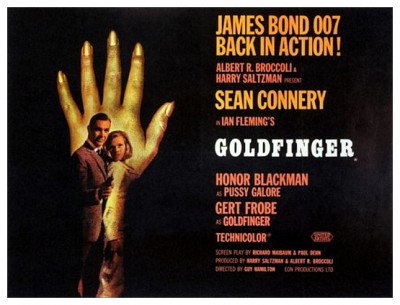 Despite Sean Connery‘s return as James Bond, Diamonds Are Forever (1971) is one of the more forgettable of the franchise. Bond thinks he has disposed of Blofeld (Charles Grey), the killer of his new bride in the previous film On Her Majesty’s Secret Service (1969), in an exciting pre-title sequence. Blofeld turns up again up much later, as the mastermind behind a scheme to use diamonds to build large crystal panels that, when attached to a communications satellite, will harness the sun’s rays to fuel a earth-threatening laser weapon.
Despite Sean Connery‘s return as James Bond, Diamonds Are Forever (1971) is one of the more forgettable of the franchise. Bond thinks he has disposed of Blofeld (Charles Grey), the killer of his new bride in the previous film On Her Majesty’s Secret Service (1969), in an exciting pre-title sequence. Blofeld turns up again up much later, as the mastermind behind a scheme to use diamonds to build large crystal panels that, when attached to a communications satellite, will harness the sun’s rays to fuel a earth-threatening laser weapon.
He is using the Las Vegas satellite base of a Howard Hughes-style billionaire recluse Willard Whyte (Jimmy Dean), whom Blofeld has kidnapped. Unfortunately, until Blofeld’s reappearance, we have to watch what is no better than a mundane diamond-smuggling melodrama, without the spectacle we usually associate with 007. The Las Vegas setting doesn’t seem exotic enough, there’s very little humour, the villains are second rate – gay assassins Mr. Kidd (Potter Smith) and Mr. Wint (Bruce Glover) are characters you’d expect to find in The Avengers fighting Steed and Mrs. Peel but not nearly as amusing – and the trouble that 007 gets into, well, even Maxwell Smart could escape. The only bright spot is moderately talented Jill St. John as a sexy diamond smuggler who gets in over head and into a number of tiny bikinis.
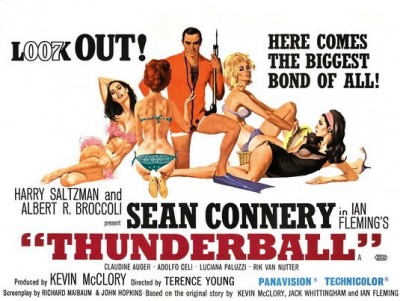 Connery’s withdrawal from the franchise sealed its aesthetic fate, although he did play Bond once more in the non-Broccoli remake of Thunderball (1965), a parody entitled Never Say Never Again (1983). Lazenby had been a disappointment in an otherwise above-average film, and the subsequent choice of Roger Moore (three years older than Connery) as Connery’s heir proved fatal to the balance between action and irony. Now the films were played strictly for laughs, to suit Moore’s personality – that of a dapper, slightly soft lounge-lizard, far too cheerful to be a killer.
Connery’s withdrawal from the franchise sealed its aesthetic fate, although he did play Bond once more in the non-Broccoli remake of Thunderball (1965), a parody entitled Never Say Never Again (1983). Lazenby had been a disappointment in an otherwise above-average film, and the subsequent choice of Roger Moore (three years older than Connery) as Connery’s heir proved fatal to the balance between action and irony. Now the films were played strictly for laughs, to suit Moore’s personality – that of a dapper, slightly soft lounge-lizard, far too cheerful to be a killer.
The remaining fun, such as it was, lay in seeing what ever-more-spectacular effect or stunt would cap the previous one. Opening sequences were sometimes so strong that the remainder of the film would prove to be an anti-climax. The best example, at the beginning of The Spy Who Loved Me (1977), had Bond on skis pursued by Russians to the brink of a quite enormous precipice in the Alps. Without pausing, Bond skis over the edge and drops like a stone for hundreds of metres, but then, just as his death seems certain, a parachute emblazoned with a Union Jack opens and he floats patriotically to the ground below. The audience generally assumed that this stunt was a clever fake by the visual effects department. In fact, it was a genuine leap by a brave lunatic by the name of Rick Sylvester, who skied in midwinter off the top of El Capitan rock in California’s Yosemite Valley, a sheer drop of two-thirds of a mile.
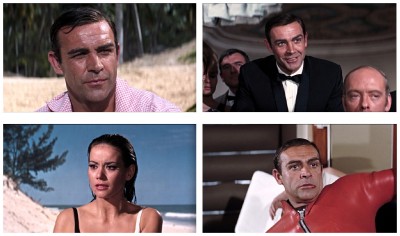 The first film in which Moore played Bond was in many respects rather mediocre – Live And Let Die (1973). The villain here was a black man (uneasily played by Yaphet Kotto, who was concerned about black dignity being impugned), and the setting was around the Caribbean. What is done extremely well is the voodoo element, especially the tall skeletal figure of Baron Samedi (Geoffrey Holder) who seems unkillable and, just when everything seems settled, reappears at the end sitting on the cow-catcher of Bond’s fast-moving train and laughing maniacally. This was a rare moment when a Bond film captured the strongly disquieting image of the uncanny.
The first film in which Moore played Bond was in many respects rather mediocre – Live And Let Die (1973). The villain here was a black man (uneasily played by Yaphet Kotto, who was concerned about black dignity being impugned), and the setting was around the Caribbean. What is done extremely well is the voodoo element, especially the tall skeletal figure of Baron Samedi (Geoffrey Holder) who seems unkillable and, just when everything seems settled, reappears at the end sitting on the cow-catcher of Bond’s fast-moving train and laughing maniacally. This was a rare moment when a Bond film captured the strongly disquieting image of the uncanny.
The trick of the unkillable killer was tried again with the steel-toothed figure of ‘Jaws’ (Richard Kiel) in The Spy Who Loved Me (1977) and Moonraker (1979), but his invulnerability is no more than a running gag. By now the films were effectively formula slapstick. For better or worse, Broccoli always had real creative input into the films and was one of the most influential producers in cinema. He found a formula and made it work, and it didn’t matter to Broccoli if intellectuals sneered at his movies, providing that the masses still went to them.
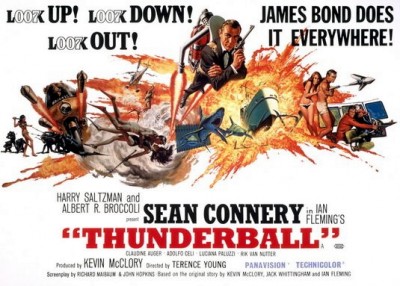 The Spy Who Loved Me (1977) is an exceptional entry to the franchise, my personal favourite among the Roger Moore Bonds, and where (for once) the huge budget is not wasted. Interestingly, while the sets and gimmicks were the most spectacular to date, Bond and the other characters are toned down, slapstick humour at a minimum, so that they are more realistic than in other Moore films, in fact this his best performance of the series. In a plot that recalls both You Only Live Twice (1967) and From Russia With Love (1963), Bond and Russian agent Major Anya Amasova (Barbara Bach) join forces to find out whose snatching nuclear submarines from the East and West. Anya wants to kill Bond because her lover was shot dead when trying to do-in 007, but instead she falls for him. They’re an appealing couple of characters, equal in every way. Their mission: apprehend villain Karl Stromberg (Curt Jergens) who wants to destroy the world and rule an underwater kingdom. The film is real treat: well-acted, smartly cast, sexy, visually impressive, lavishly produced, powerfully directed by Lewis Gilbert, a mix of spy romance and a war-mission film. Richard Kiel’s seven-foot-tall metal-toothed henchman ‘Jaws’ would appear in the next Bond film, the lamentable Moonraker (1979).
The Spy Who Loved Me (1977) is an exceptional entry to the franchise, my personal favourite among the Roger Moore Bonds, and where (for once) the huge budget is not wasted. Interestingly, while the sets and gimmicks were the most spectacular to date, Bond and the other characters are toned down, slapstick humour at a minimum, so that they are more realistic than in other Moore films, in fact this his best performance of the series. In a plot that recalls both You Only Live Twice (1967) and From Russia With Love (1963), Bond and Russian agent Major Anya Amasova (Barbara Bach) join forces to find out whose snatching nuclear submarines from the East and West. Anya wants to kill Bond because her lover was shot dead when trying to do-in 007, but instead she falls for him. They’re an appealing couple of characters, equal in every way. Their mission: apprehend villain Karl Stromberg (Curt Jergens) who wants to destroy the world and rule an underwater kingdom. The film is real treat: well-acted, smartly cast, sexy, visually impressive, lavishly produced, powerfully directed by Lewis Gilbert, a mix of spy romance and a war-mission film. Richard Kiel’s seven-foot-tall metal-toothed henchman ‘Jaws’ would appear in the next Bond film, the lamentable Moonraker (1979).
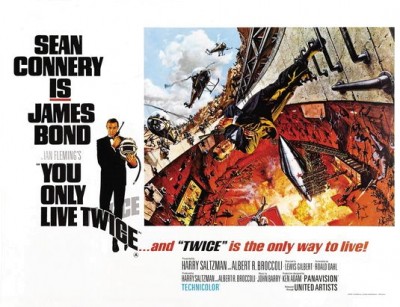 Widely considered the worst of the franchise, Moonraker (1979) has Moore walking through the paces for his hefty pay-cheque and giving way to his double during a series of unimaginative action sequences and so-called ‘humorous’ chases. There’s very little suspense and the humour falls flat. Not only is ‘Jaws’ wasted, pacified by love so that he becomes a good guy, but the filmmakers also have the gall to set the finale in outer space to stage a laser battle in an attempt to capitalise on the Star Wars IV A New Hope (1977) box-office. The plot has billionaire industrialist Hugo Drax (Michael Lonsdale) setting up a space station from where he hopes to wipe out the earth’s population and replace it with his own super-race. Great soundtrack by John Barry with a terrific title song by Shirley Bassey, fantastic special effects by Derek Meddings and his team, and the cool-as-a-cucumber super-villain are all wasted.
Widely considered the worst of the franchise, Moonraker (1979) has Moore walking through the paces for his hefty pay-cheque and giving way to his double during a series of unimaginative action sequences and so-called ‘humorous’ chases. There’s very little suspense and the humour falls flat. Not only is ‘Jaws’ wasted, pacified by love so that he becomes a good guy, but the filmmakers also have the gall to set the finale in outer space to stage a laser battle in an attempt to capitalise on the Star Wars IV A New Hope (1977) box-office. The plot has billionaire industrialist Hugo Drax (Michael Lonsdale) setting up a space station from where he hopes to wipe out the earth’s population and replace it with his own super-race. Great soundtrack by John Barry with a terrific title song by Shirley Bassey, fantastic special effects by Derek Meddings and his team, and the cool-as-a-cucumber super-villain are all wasted.
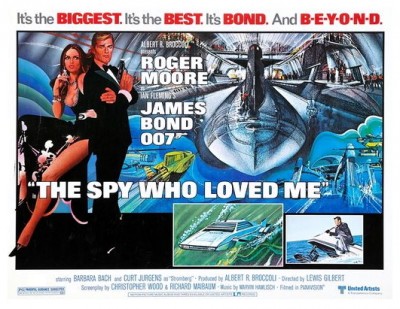 After the embarrassing fiasco of Moonraker (1979), Broccoli vowed to return a grittier more down-to-earth Bond with For Your Eyes Only (1981) scripted by Richard Maibaum and Michael G. Wilson, which takes a more realistic approach and an unusually strong narrative theme of revenge and its consequences. A ship goes down off Greece carrying a device needed to launch nuclear missiles from British submarines. Bond teams up with a lovely marine biologist (Carole Bouquet), whose parents were ordered killed by a Greek villain (Julian Glover) who’s working for the Russians. He’s passing himself off as the sponsor of a young skater (Lynn-Holly Johnson). Bond finds adventure underwater and high in the mountains. There are exciting moments, but most of it is familiar Bond fare in an attempt to mix spectacle with tough believable storylines of the early Bond films, and Moore does a good job, coming through as a convincing action hero for a change.
After the embarrassing fiasco of Moonraker (1979), Broccoli vowed to return a grittier more down-to-earth Bond with For Your Eyes Only (1981) scripted by Richard Maibaum and Michael G. Wilson, which takes a more realistic approach and an unusually strong narrative theme of revenge and its consequences. A ship goes down off Greece carrying a device needed to launch nuclear missiles from British submarines. Bond teams up with a lovely marine biologist (Carole Bouquet), whose parents were ordered killed by a Greek villain (Julian Glover) who’s working for the Russians. He’s passing himself off as the sponsor of a young skater (Lynn-Holly Johnson). Bond finds adventure underwater and high in the mountains. There are exciting moments, but most of it is familiar Bond fare in an attempt to mix spectacle with tough believable storylines of the early Bond films, and Moore does a good job, coming through as a convincing action hero for a change.
The film itself is terrific when compared to Moonraker and it’s enjoyable while watching it, but afterward it’s one of the most forgettable of the Bond series. In fact, the title sequence in which Sheena Easton sings the hit title song while standing nude in the water is probably the movie’s most memorable scene. Bernard Lee, who had played ‘M’ since Doctor No (1962), sadly passed away before filming began. This was also the last Bond film to be distributed solely by United Artists, as the studio merged with MGM.
 Loosely based on two of Ian Fleming‘s short stories, Octop**sy (1983) finds 007 tracking down the murderers of 009. He uncovers a plot by a renegade Russian general (Steven Berkoff) and a wealthy Afghan prince (Louis Jordan) to detonate an atomic bomb at a US air-force base in Germany. They reason that the public will conclude that a nuclear accident caused the deaths of thousands of innocent people and will press for unilateral disarmament by the Western bloc. The movie has slow spots, very little humour and villains who aren’t nearly of the calibre of Doctor No (1962), Goldfinger (1964) or Blofeld. The filmmakers also make the mistake of demeaning Bond by having him swing through the trees emitting a Tarzan cry and having him hide in a gorilla suit, and later disguise himself as a clown. It’s as if they’re trying to remind us that everything is tongue-in-cheek – but that doesn’t make sense because this is much more serious than typical Bond outings, recalling the tone of From Russia With Love (1963). Nevertheless, it is fairly entertaining, with a sturdy performance from Moore, twin knife-throwers that Bond has to dispose of, beautiful Bond girls and several exciting action sequences. Maud Adams plays the title character, the leader of a female smuggling gang and a difficult (but not impossible) conquest for Bond.
Loosely based on two of Ian Fleming‘s short stories, Octop**sy (1983) finds 007 tracking down the murderers of 009. He uncovers a plot by a renegade Russian general (Steven Berkoff) and a wealthy Afghan prince (Louis Jordan) to detonate an atomic bomb at a US air-force base in Germany. They reason that the public will conclude that a nuclear accident caused the deaths of thousands of innocent people and will press for unilateral disarmament by the Western bloc. The movie has slow spots, very little humour and villains who aren’t nearly of the calibre of Doctor No (1962), Goldfinger (1964) or Blofeld. The filmmakers also make the mistake of demeaning Bond by having him swing through the trees emitting a Tarzan cry and having him hide in a gorilla suit, and later disguise himself as a clown. It’s as if they’re trying to remind us that everything is tongue-in-cheek – but that doesn’t make sense because this is much more serious than typical Bond outings, recalling the tone of From Russia With Love (1963). Nevertheless, it is fairly entertaining, with a sturdy performance from Moore, twin knife-throwers that Bond has to dispose of, beautiful Bond girls and several exciting action sequences. Maud Adams plays the title character, the leader of a female smuggling gang and a difficult (but not impossible) conquest for Bond.
A View To A Kill (1985) was Roger Moore‘s final entry in the series, and he looks trimmer and more energetic than in some of his previous efforts. This time 007 is pitted against a master criminal (Christopher Walken) who intends to blow up Silicon Valley. The action takes place all over the globe, in the air, on the ground, underwater. I wish Bond had a few more of his famous gadgets on hand, but his action scenes are exciting and some of the stunts are spectacular, even though it’s too easy to see that Moore has a stand-in. Walken is the first Bond villain who is not so much evil as a crazed neurotic, but viewers may be more interested in his lover and right-hand-woman Mayday (Grace Jones) whose exotic features and lightning-quick karate moves make her an intimidating presence. Unfortunately the filmmakers – who ruined the villain ‘Jaws’ by making him a nice guy in Moonraker (1979) – make the same mistake here by switching Mayday at the end from his nemesis to his accomplice, depriving us of a slam-bang fight to the finish between the two. Leading lady Tanya Roberts has to get by on beauty alone since she is stuck with a character who is the least mysterious of Bond’s women to date. The film lacks the flamboyance of other Bond movies and has a godawful slapstick chase sequence through San Francisco, but overall it’s fast-paced, fairly enjoyable and a worthy entry in the franchise.
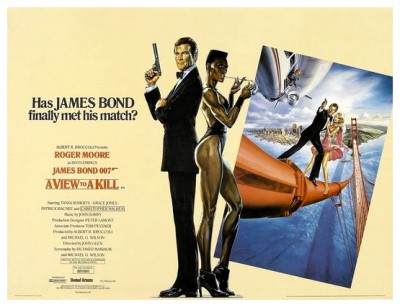 Roger Moore remains the longest-serving James Bond actor, having spent twelve years in the role (1973 to 1985) making seven official films in a row. Moore is also the oldest actor to have played Bond and was fifty-eight years old when he announced his retirement in 1985. Moore’s Bond was very different than the character created by Ian Fleming, and screenwriters like George MacDonald Fraser provided scenarios in which 007 was a seasoned debonair playboy who would always have a trick up his sleeve or a gadget in stock when he needed it, which was designed to serve the contemporary taste during the seventies.
Roger Moore remains the longest-serving James Bond actor, having spent twelve years in the role (1973 to 1985) making seven official films in a row. Moore is also the oldest actor to have played Bond and was fifty-eight years old when he announced his retirement in 1985. Moore’s Bond was very different than the character created by Ian Fleming, and screenwriters like George MacDonald Fraser provided scenarios in which 007 was a seasoned debonair playboy who would always have a trick up his sleeve or a gadget in stock when he needed it, which was designed to serve the contemporary taste during the seventies.
In 1986, Pierce Brosnan was approached play Bond, but was unable get out of contractual commitments to the television series Remington Steele, so the next actor on the producer’s list of possible Bonds was approached – Timothy Dalton. But that’s another story for another time. Right now it’s time for me to bid you a fond farewell, but not before acknowledging the extensive documentaries featured on the DVD releases of each Bond film for assisting my research for this article, and invite you to please join me again next week as we see what the postman leaves on my doorstep – and sets on fire – for…Horror News! Toodles!
 Horror News | HNN Official Site | Horror Movies,Trailers, Reviews
Horror News | HNN Official Site | Horror Movies,Trailers, Reviews
